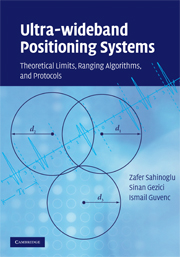Book contents
- Frontmatter
- Contents
- Preface
- 1 Introduction
- 2 Ultra-wideband signals
- 3 Ultra-wideband channel models
- 4 Position estimation techniques
- 5 Time-based ranging via UWB radios
- 6 Ranging protocols
- 7 Special topics in ranging
- 8 Practical considerations for UWB system design
- 9 Recent developments and future research directions
- References
- Index
Preface
Published online by Cambridge University Press: 23 December 2009
- Frontmatter
- Contents
- Preface
- 1 Introduction
- 2 Ultra-wideband signals
- 3 Ultra-wideband channel models
- 4 Position estimation techniques
- 5 Time-based ranging via UWB radios
- 6 Ranging protocols
- 7 Special topics in ranging
- 8 Practical considerations for UWB system design
- 9 Recent developments and future research directions
- References
- Index
Summary
Ability to locate assets and people will be driving not only emerging location-based services, but also mobile advertising, and safety and security applications. Cellular subscribers are increasingly using their handsets already as mapping and navigation tools. Location-aware vehicle-to-vehicle communication networks are being researched widely to increase traffic safety and efficiency. Asset management in warehouses, and equipment and personnel localization/tracking in hospitals are among other location-based applications that address vast markets. It is a fact that application space for localization technologies is very diverse, and performance requirements of such applications vary to a great extent.
The Global Positioning System (GPS) requires communication with at least four GPS satellites, and offers location accuracy of several meters. It is used mainly for outdoor location-based applications, because its accuracy can degrade significantly in indoor scenarios. Wireless local area network (WLAN) technology has recently become a candidate technology for indoor localization, but the location accuracy it offers is poor, and also high power consumption of WLAN terminals is an issue for power-sensitive mobile applications. Ultra-wideband technologies (UWB) promise to overcome power consumption and accuracy limitations of both GPS and WLAN, and are more suitable for indoor location-based applications.
The Federal Communications Commission (FCC) and European Commission (EC) regulate certain frequency bands for UWB systems. These have prompted worldwide research and development efforts on UWB. Another consequence was development of international wireless communication standards that adopt UWB technology such as IEEE 802.15.4a WPAN and IEEE 802.15.3c WPAN.
The writing of this book was prompted by the fact that UWB is the most promising technology for indoor localization and tracking.
- Type
- Chapter
- Information
- Ultra-wideband Positioning SystemsTheoretical Limits, Ranging Algorithms, and Protocols, pp. ix - xiiPublisher: Cambridge University PressPrint publication year: 2008



